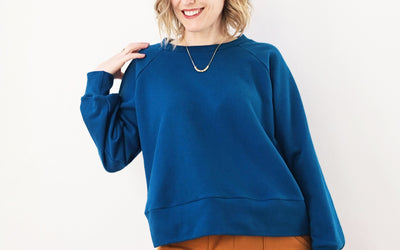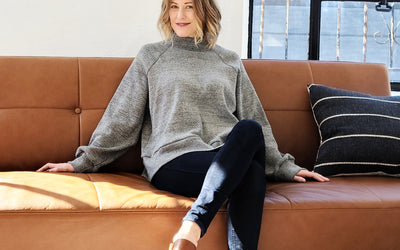
Raise your hand if you have multiple giant bags/baskets/bins of scraps. Everyone? Yeah, I thought so. We've been brainstorming ways to use up linen scraps, as those are the most common scraps we seem to end up with around here. In this blog post, we want to show you one way to use up some of those scraps by making a duvet cover. And by the way, you can use fabrics scraps other than linen.

We are always in need of duvet covers in my household. We have a lot of duvets and the covers are constantly wearing out and looking ratty. I have ended up with an abundance of flat sheets because I have purchased so many sheet sets over the years but only use the fitted sheets. We opt to use high thread count duvet covers that can lay right next to our skin rather than flat sheets. So with lots of flat sheets and scraps, the idea to make duvet covers out of them occurred to me. Now I am not a quilter, I don't have quilting skills and don't have a lot of time to work on intricate quilting with scrap projects but I can manage sewing some scraps together for a duvet cover. So I tasked Windsor (who no longer works here with us and we miss her dearly) with this scrap busting tutorial below to create a fun duvet cover. A much quicker project than a quilt and it makes a very useful gift as well.
Supplies:
- Scraps! I used mostly linen scraps, but you can choose to use whatever you have. Natural fiber materials will work best, medium weight and with some structure is great. Be sure to use fabrics with the same or similar contents and weight. We snuck some cotton scraps in with the linen and it all seemed to wash up nicely together but do try to use the same type of fabrics throughout.
- A retired flat sheet - for the back (the side that will be closest to the body). You can also use fabric but it does feel nice to have a high thread count fabric on the underside.
- Thread - I used up old bobbins and leftover thread spools from other projects.
Since I had so many medium - large size linen scraps to work with I decided to make a very scrappy top for my duvet. You can make your duvet cover as scrappy as you want. You could follow a quilt pattern, or incorporate traditional quilt blocks into your patchwork. You could make stripes or a checkerboard, appliques or just randomly sew pieces together - whatever your heart desires.

Here is a table for approximate duvet cover sizes. I made a twin size duvet cover, so roughly 68" x 86". You want your duvet to fit snugly in the cover so it is lofty.

The first thing I did was start playing with how my scraps worked with each other. I noticed that I had lots of blues and greens to work with, so I decided to stick to a mostly blue/green palette, with a couple pops of warmer colors.

Once I decided how I wanted my scraps to fit together, I serged all the edges. If you are a very patient person, you could use French seams on your patchwork, this would create a very polished and beautiful duvet cover. I am not that patient, so after serging all my pieces, I sewed them together, row by row, with a 1/2" seam allowance. Then I pressed all my seams open.

When my duvet cover top was complete I made some short ties to add into the corners, to hold the comforter in place within the duvet cover. This is an optional detail, but one I like to add, since it is very frustrating when your comforter shifts around inside its duvet cover.

First, I cut a strip of fabric ~16" long by 2.5" wide. I pressed it in half lengthwise.

Then I pressed the raw edges in to the centerline. Then I topstitched the folded tie approximately 1/8" from the open edge. Then I cut my tie in half, resulting in two ~8" ties, one for each top corner of my duvet cover.

I basted these ties onto the wrong side of the top corners of my duvet cover.

Now that the duvet cover top is prepped, I hemmed the bottom edge to prepare for buttonholes. First, I pressed the bottom edge (the short edge opposite the top corners with the ties) to the wrong side 1.5".

Then I pressed it to the wrong side 1.5" a second time, enclosing the serged edge.

Then I edgestitched the hem at 1/8".
You could add some light weight fusible interfacing to the buttonhole areas for before stitching up the hem. This will help stabilize the buttonholes. The interfacing needs only to be about 1/4" larger than the buttonhole dimensions.

Next I marked in 10" from the side edge on both sides of the bottom hem.

Later I will sew the bottom of my duvet cover closed just to these 10" marks. That way I will still have an opening at the bottom of my duvet cover to insert my comforter, but the opening will not be the entire length of the bottom.

Next, I decided how many buttons and buttonholes I wanted to add to secure the bottom opening, and marked my buttonholes. I had 5 buttons that I wanted to use, so I measured the length of my opening and divided that number by 5. I marked my buttonholes roughly every 8". You may decide that you want your buttonholes more or less spaced out, do what you want! You could also use snaps or ties if you don't want to use buttons.

I sewed my buttonholes as they were marked, used Fray-Check on them to keep them from fraying, and cut them open! We're getting so close!
Since I was using an old flat sheet for my duvet cover back, I planned to use the fancy top hem as the button band. I folded it to the wrong side 1.5" and edgestitched that fold. Then I cut my sheet to size. I cut it 68" wide and 1.5" longer than my patchwork top, so 87.5" long. Then I serged the raw edges.

Next, I lined up the wrong side of the bottom edge of my sheet (the button band), and the right side of my duvet top. I place a pin at my 10" marking.

Then I stitched the duvet top to the bottom sheet, to my marked 10" line.
After attaching the duvet top to the duvet bottom at the button band, I laid the duvet bottom on the duvet top, right sides together, and stitched together the other three sides of the duvet cover with a 1/2" seam allowance. Then I turned it right side out, making sure to poke out the corners. The last step was marking and attaching my buttons to the button band.
And here's the finished product!

We hope you enjoyed this tutorial!
Peggy & Windsor


